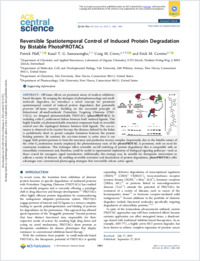Reversible Spatiotemporal Control of Induced Protein Degradation by Bistable PhotoPROTACs.
- Pfaff P Department of Chemistry and Applied Biosciences, Laboratory of Organic Chemistry, ETH Zürich, Vladimir-Prelog-Weg 3, 8093 Zürich, Switzerland.
- Samarasinghe KTG Department of Molecular, Cell, and Developmental Biology, Yale University, 260 Whitney Avenue, New Haven, Connecticut 06511, United States.
- Crews CM Department of Molecular, Cell, and Developmental Biology, Yale University, 260 Whitney Avenue, New Haven, Connecticut 06511, United States.
- Carreira EM Department of Chemistry and Applied Biosciences, Laboratory of Organic Chemistry, ETH Zürich, Vladimir-Prelog-Weg 3, 8093 Zürich, Switzerland.
- 2019-10-30
Published in:
- ACS central science. - 2019
English
Off-tissue effects are persistent issues of modern inhibition-based therapies. By merging the strategies of photopharmacology and small-molecule degraders, we introduce a novel concept for persistent spatiotemporal control of induced protein degradation that potentially prevents off-tissue toxicity. Building on the successful principle of bifunctional all-small-molecule Proteolysis Targeting Chimeras (PROTACs), we designed photoswitchable PROTACs (photoPROTACs) by including ortho-F4-azobenzene linkers between both warhead ligands. This highly bistable yet photoswitchable structural component leads to reversible control over the topological distance between both ligands. The azo-cis-isomer is observed to be inactive because the distance defined by the linker is prohibitively short to permit complex formation between the protein binding partners. By contrast, the azo-trans-isomer is active since it can engage both protein partners to form the necessary and productive ternary complex. Importantly, due to the bistable nature of the ortho-F4-azobenzene moiety employed, the photostationary state of the photoPROTAC is persistent, with no need for continuous irradiation. This technique offers reversible on/off switching of protein degradation that is compatible with an intracellular environment and, therefore, could be useful in experimental exploration of biological signaling pathways-such as those crucial for oncogenic signal transduction. Additionally, this strategy may be suitable for therapeutic intervention to address a variety of diseases. By enabling reversible activation and deactivation of protein degradation, photoPROTACs offer advantages over conventional photocaging strategies that irreversibly release active agents.
- Language
-
- English
- Open access status
- gold
- Identifiers
-
- DOI 10.1021/acscentsci.9b00713
- PMID 31660436
- Persistent URL
- https://folia.unifr.ch/global/documents/76288
Statistics
Document views: 23
File downloads:
- Full-text: 0
